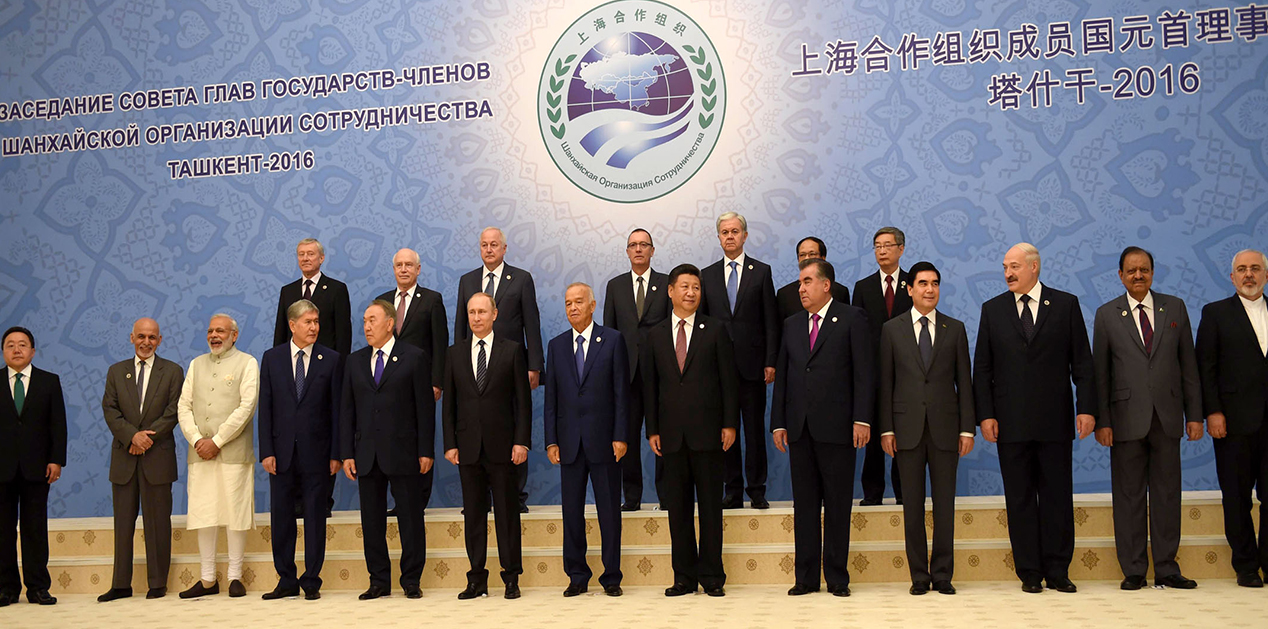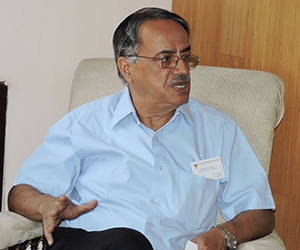India came one step closer to becoming a full-fledged member of the Shanghai Cooperation Organization (SCO), at the summit held last month. Some of the required procedures were yet to be completed. For instance, there are about 28 documents which have to be signed by India. Although a degree of dissonance might have resulted due to Prime Minister Narendra Modi’s unsuccessful intervention with President Xi Jinping on the sidelines of the SCO summit to get China to support India’s bid for entry into NSG, the salience of SCO and opportunities presented by the platform remain significant for New Delhi.
The evolving regional security situation mandates high level of coordination and cooperation between Central Asian countries, India and other members of SCO. The Taliban is once again very active in Northern Afghanistan which abuts the Central Asian countries. Security in the Central and South Asia has assumed added importance after reduced profile of the US and NATO forces in Afghanistan since December 2014. Recent incidents also indicate that Afghan National Security Forces (ANSF) lack adequate fire power in terms of air and logistics capabilities to sustain a long term counter insurgency campaign. The evolving security situation thus poses a challenge to India as well as Central Asian states.
To manage this challenge there is a need for cooperation between states in Central and South Asia including Russia, China and Iran. Given the nature of relationship between India and Pakistan, evolution of cooperative security architecture remains a major challenge. Pakistan’s denial of access routes to India to Afghanistan and Central Asia has prevented direct linkages between the two regions as a whole.
In this scenario Shanghai Cooperation Organisation (SCO) assumes importance for this is the only regional cooperative political, diplomatic and part security architecture which provides a platform for interaction between South and Central Asia. The SCO format where there is very stringent criteria to air bilateral differences in the common forum, restraints are expected to be imposed on the member countries while providing a common platform for discussion of various issues of common interests.
SCO and India: Many Opportunities
The SCO brings together three principal players in Asia – Russia (a Eurasian power), China and India on the same platform. India, China and Russia are already cooperating in forums like RIC, BRICS, G-20 and others. This is likely to help bring India closer to China by supporting the only multilateral security entity outside the United Nations that China has created. Thus entry to the SCO will likely ensure that India is accepted as a part of the overall Eurasian sphere of influence in which it was denied a role so far.
India’s growing interest in Central Asia was highlighted by Prime Minister Modi’s visit to the five countries of the region along with his visit to Russia last year. The relationship with Central Asia is one of India’s untapped opportunities. Indian soft power already has considerable influence in Central Asia, far more than China. The SCO will provide a good forum to expand on some of the hardcore issues such as economy trade and counter terrorism cooperation. This approach also gels very well with multi-vector policies of Central Asian countries. These countries could also gain from the techno-economic- potential of India, which could be accessed in cooperative, mutually beneficial partnerships. Central Asia’s desire for diversifying hydro-power and energy export routes would correspond with India's quest for diversifying imports. India has been keen to invest in setting up downstream production facilities, instead of exporting raw materials out of the region through expensive pipelines. The approach could differ from those seeking exclusively to pump out Central Asia's riches.
India is looking intently at the region through the framework of its ‘Connect Central Asia’ policy, which is based on pro-active political, economic and people-to-people engagement with Central Asian countries, both individually and collectively. India’s Connect Central Asia Policy that was put into motion in 2012 is expected to receive a boost with India becoming a member. The objectives of this policy would be better realized with India being inside rather than outside the SCO.
On the other hand, China and India will be able to hold constructive conversations on a wide range of issues in the SCO--from Asian Infrastructure Investment Bank membership to joint counter-terrorism exercises. This will add to the existing platforms of cooperation with China amongst other members of the SCO.
The regular leadership and other meetings around the SCO means that both Indian and Pakistani officials at a senior level from Prime Minister and head of state meetings to Health Ministers, Foreign Ministers and Interior Minister meetings will encounter each other at least once a year, away from the glare of the annual September UN General Assembly meeting. This will provide another neutral forum in which the two countries would have an opportunity to interact. The Ufa joint statement issued in July 2015 by India and Pakistan on the sidelines of the SCO summit last year could be seen as a positive development. However, it can also be said that Pakistan would be tempted to raise bilateral issues as has been its wont in other multilateral platforms.
In the sphere of counter terrorism SCO’s Regional Anti-Terrorism Structure (RATS) centre in Tashkent which is a repository of information of proscribed individuals could be of much use for India. Participation in RATS may bring some new levels of intelligence sharing, as well as help the others develop counter-terrorism strategies based on India’s long experience.
Post-2014 Afghanistan has seen a deterioration in the security environment particularly so in Northern Afghanistan. Moreover there have been a series of attacks on Indian assets including the consulate in Mazar-e-Sharif in the North. It is expected that engagement with the SCO countries will provide higher degree of clarity and coordination of policies on this important country which has implications for regional security.
India could also gain from access to Central Asia’s minerals and energy, as also market access to Russia and ultimately Europe. Central Asia is still deeply underdeveloped, offering an entree for Indian construction firms and others. The membership of SCO will provide greater accessibility to gas and oilfields in the region with projects as TAPI and development of the North South Trans Eurasian transport network. Though given the state of security situation in the Af-Pak region realization of TAPI seems highly unlikely.
Challenges and Possible SCO Assistance
The main problem for India in access to SCO countries is the physical impediment of Afghanistan and Pakistan. This reality complicates relations, but India has sought to overcome it by developing the Chabahar Port in Iran, an alternative route for Indian products from Central Asia. From Chabahar port using the existing Iranian road network, one can link up to Zaranj in Afghanistan which is at a distance of 883 km from the port and then using the Zaranj-Delaram road constructed by India in 2009, one can access Afghanistan`s garland highway thereby establishing road access to four of the major cities of Afghanistan; Herat, Kandahar, Kabul and Mazar-e-Sharif. From there is effective access to Central Asia.
For this purpose the Chabahar Agreement also known as the International Transport and Transit Corridor Agreement between governments of Afghanistan, India and Iran has been drafted and will be signed in Kabul in the next two months. This will be boosted by the Ashgabat Agreement which has Oman, Iran, Turkmenistan and Uzbekistan as founding members. Kazakhstan has also joined this arrangement subsequently. Accession to the Agreement would enable India to utilise this existing transport and transit corridor to facilitate trade and commercial interaction with the Eurasian region. Further, this would synchronise efforts to implement the International North South Transport Corridor (INSTC) for enhanced connectivity. Not only there is a need to invest more in the Chabahar project but also the implementation has to done in the laid down time frame.
The SCO could be a useful platform for coordinating the connectivity plans of the members in the region. For instance, synergies could be obtained between China’s ‘Belt and Road Initiative’ and India’s ‘Connect Central Asia Policy’.
Military and Security Aspects
India is not in favour of converting the SCO into a military block. It is yet to be seen what would be level of Indian military’s participation in the joint military exercises that are regularly conducted by the SCO. In any case Indian military has been carrying out joint counter terrorism exercises with China and Russia besides with some other Central Asian countries in a bilateral mode.
Also given the nature of India’s foreign and security policies India’s joining of SCO will further put to rest speculation that SCO is developing into a NATO of the East or as a counterweight to NATO.
Bringing peace, stability and prosperity to the Central Asian region is an imperative if the stated objectives of India, China and Russia are to be realized. Irrespective of the differences between these countries there are many convergences which need to be capitalised on. Connectivity plans of the member countries need to be synchronised to get the best fit and concomitant benefits for the region and all those involved.
While the future potential of SCO is vast, the ability of the organisation to deliver particularly in the security and economic sphere has been limited thus expectations in India may have to be reasonably low at least in the initial stages.
Published Date: 20th July 2016, Image Source: http://indianexpress.com
(Disclaimer: The views and opinions expressed in this article are those of the author and do not necessarily reflect the official policy or position of the Vivekananda International Foundation)











Post new comment